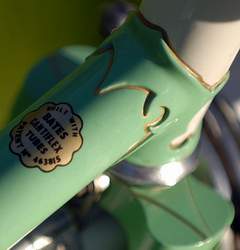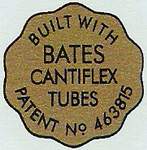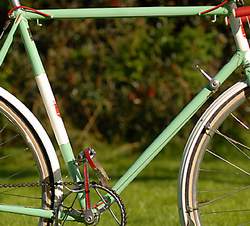Bates Cycles - Cantiflex frame tubes
Posted: Thursday 28th May 2020
Cantiflex frame tubing
Frame flex has always been an issue with cycle frames, especially on lightweight racing machines where the wall thickness of the main tubes is measured in thousanths of an inch. Flex is to be avoided because a whippy frame not only causes handling problems but it also absorbs energy that would be better employed propelling the rear wheel rather than twisting the frame during each pedal stroke.
Horace Bates recognised early on that making frames with larger diameter tubing could improve matters considerably because the resultant structure would be stiffer, thus reducing the power-sapping effects of frame flex. Keen to develop his ideas, he experimented with larger-diameter tubing and this did indeed result in a stiffer structure. However, although the larger sized tubing could be obtained, the lugs that formed the joints were simply not available to suit.

A solution was found when Horace Bates hit upon the notion of using frame tubing that was the industry standard size at each end but which bulged out by approx 5-6mm to create a larger diameter in the centre. This double-taper tube not only solved the problem of obtaining oversized lugs, as the ends were the standard size, but it also resulted in a frame design with the optimum strength and weight because the main frame tubes would be stiffer in the centre section where the ‘bending moment’ was at its greatest. Also, by specifying double butted tubing (where wall thickness is less in the centre of each tube length and thicker at each end), there would be virtually no weight penalty for these stiffer tubes while the thicker ends would remain strong at the point where thickness is vital to create a strong joint.

Here is the description from the Bates brochure of 1939:
The inside and outside diameters of the tube are larger towards the centre, while the thickness of the metal is increased at each end. By increasing the diameter of the tube where the greatest bending strain occurs, extreme rigidity results and light gauge material may be used, and by increasing that gauge, strength is added at the points where the breaking load is greatest… thus…CANTIFLEX tubes are lighter, stronger and more rigid…. They prevent whip, ensuring that ALL energy is transmitted into drive.
A stronger and stiffer frame with no weight penalty was the holy grail of all frame-builders. Horace Bates had discovered it and claimed it as his own. Indeed, much was made from the perception that to ride a Cantiflex-framed Bates would make you a faster rider. ‘Bates is the fastest and only really rigid handbuilt’ stated the brochure. Few would have argued otherwise.

Actually, the design appears to have been tried a few years earlier by another London frame maker. Notwithstanding this, Horace Bates was able to patent and register the design. Clearly he knew a good thing when he saw it and also had the vision to put it to good use. The next step was to commission Reynolds to produce a batch of frame tubes to this specification in their highest grade double-butted 531 steel-alloy material. With this achieved and the design patented in 1935, production of Cantiflex frames began in February 1936.
The patent specification stated that the objective was:
…. to provide a construction whereby the strength and rigidity of the frame is increased and the so called “whip”, or vibration of the tubes, which is known to absorb some of the energy expended by the cyclist is wholly or substantially eliminated.
That the design works is not in question. A Bates with Cantiflex tubes does have a reassuringly stable feel to it and these machines are renowned for their responsiveness and efficiency.

For the sceptics, Horace Bates arranged for both Cantiflex and normal section 531 frame tubes to be tested by the National Physical Laboratory at Teddington. The result was that the Cantiflex tubes were able to withstand a loading at least 30 per cent greater than the normal frame tubing. Standard-section tubes broke down at 850lb loading. The Cantiflex tubes were still holding out at 1120lb load. And yet these tubes have a wall thickness of just 32 thousandths of an inch – even less towards the centre section – so they are extremely light weight as well as strong.
It is perhaps no coincidence that Ernesto Colnago employed a similar concept with the famed Master model as used by so many pro riders of the 1980s and 1990s. The Colnago Master employed frame tubing of a slightly greater diameter (and different sectional shape too) in the centre than at each end. Nothing is ever really new in bicycle design, is it?
Posted: Thursday 28th May 2020
This article appears in the following categories.
Upcoming Events
Whether you are looking for a gentle social meet up, or a 100-mile ride browse the community’s upcoming events and plan your next weekend outing.
